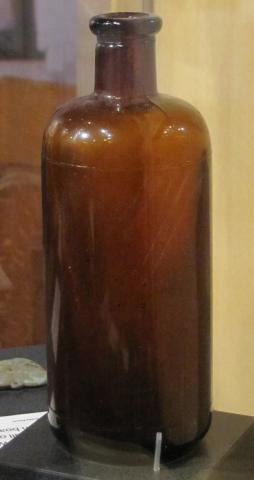This bottle came from the mining town of Buxton, Iowa. Buxton was a mining town founded in 1895 by the Consolidation Coal Company (CCC), which supplied the Chicago and Northwestern Railway. The company established Buxton after a four-year search for new coal veins. After its search, the company purchased 8600 acres of land in Monroe County and 1600 acres in neighboring Mahaska County in 1900 for $275,000. The mining business drew approximately 5,000 people to Buxton, creating a thriving economic and social community. Buxton soon became the largest unincorporated city in the nation and the largest coal town west of the Mississippi River. The prosperous coal mining town was one of few in Iowa's history to have a majority African American population. Equality was an important part of Buxton's success. Miners were paid equal wages, a standard home was provided for each family, and segregation was not allowed. Many African Americans became prominent business and community leaders. At a time when racism and segregation were prevalent in American society, the residents of Buxton experienced relative equality. Five years after the town was established, 55% of its residents were African American. Buxton experienced a series of events that led to its slow demise beginning in 1914. That year, miners worked fewer days due to labor disputes, an explosion in one of the town's nearby mines led to its permanent closure, and the CCC established a new coal camp ten miles west of Buxton. All three events drew residents out of the town, a trend that continued in the following years when large fires destroyed parts of Buxton and nearby settlements. Furthermore, after the coal boost provided by World War I ended in 1917, the coal industry in Iowa rapidly declined. The industrialization of coal mining also contributed to Buxton's decline, as Iowa's coal formations did not adapt well to large-scale mining operations and railroads began to rely more heavily on eastern coal. By 1916, the Iowa Bystander, an African American newspaper, observed that Buxton "looked like a deserted village." By 1919, the population of Buxton had dwindled to less than 400, and in 1923, Consolidation Coal Company moved its headquarters out of Buxton. Two years later, the company was bought out by Superior Coal Company. In 1927, Super Coal Company closed its last mine in Monroe County. In the early 1980s, Iowa State University conducted an archaeological dig at the Buxton site. Using maps, old photographs, oral histories, and the help of former residents, historians and archaeologists uncovered Buxton. As a result of the project, the Buxton site was placed on the National Register of Historic Places, a list maintained by the National Park Service, in 1983. Content can be used with the following standards: 2nd grade SS 2.24 Natural Resources, 4th grade SS 4.25 Technological Changes, 5th grade SS 5.26 Civil Rights, and SS Econ. 9-12.24 Iowa Economy Impact in a lesson on civil rights in Iowa and the Iowan industries impact on the economy. For any use other than instructional resources, please check with the organization that owns this item regarding copyright restrictions.
2018.012.020 [Bottle]
Legal Status
Ownership of this resource is held by the African American Museum of Iowa and has been provided here for educational purposes only, specifically for use in the Iowa Museum Association's "Teaching Iowa History" project. It may not be downloaded, reproduced or distributed in any format without written permission from the Rights Holder. For information on U.S. and International copyright laws, consult an attorney.

